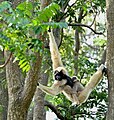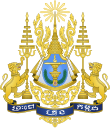Wildlife of Cambodia
This article needs additional citations for verification. (March 2013) |


The wildlife of Cambodia is very diverse with at least 162 mammal species,[1] 600 bird species,[1] 176 reptile species (including 89 subspecies),[2] 900 freshwater fish species,[1] 670 invertebrate species, and more than 3000 plant species.[1] A single protected area, Keo Seima Wildlife Sanctuary, is known to support more than 950 total species, including 75 species that are listed as globally threatened on the IUCN Red List.[3] An unknown amount of species remains to be described by science, especially the insect group of butterflies and moths, collectively known as lepidopterans.[4]
Many species in Cambodia, including several endemic ones, are recognized by the IUCN or World Conservation Union as threatened, endangered, or critically endangered due to deforestation and habitat destruction, poaching, the illegal wildlife trade, and farming, fishing, and forestry concessions. Intensive poaching may have already driven Cambodia's national animal, the kouprey, to extinction, wild tigers to extirpation, and Eld's deer, wild water buffaloes and hog deer are at critically low numbers.
Wildlife in Cambodia includes dholes, elephants, deer (sambar, Eld's deer, hog deer and muntjac), wild oxen (banteng and gaur), panthers, bears, and tigers. Cormorants, cranes, ibises, parrots, green peafowl, pheasants, and wild ducks are also found, and species of venomous snakes and constrictors are numerous. Deforestation, mining activities, and unregulated hunting, have diminished the country's wildlife diversity rapidly.
Cambodia also has many endangered species, including Asian elephant, Siamese crocodile, wild water buffalo, and the Germain's silver langur.
Much work is being done in this area to help conserve and protect Cambodia's unique wildlife. Wildlife conservation organizations operating in Cambodia include Conservation International, World Wildlife Fund, the Wildlife Conservation Society, Fauna and Flora International, BirdLife International, Wildlife Alliance, and many others. On 20 December 2016, 163 new animal species were reported in Southeast Asia including one known as the for its resemblance to a Klingon from Star Trek.[5]
Fauna[]

Some animals native to Cambodia:
Mammals[]
- Asian black bear
- Asian elephant
- Asian golden cat
- Banteng - endangered
- Binturong - vulnerable
- Clouded leopard
- Dhole
- Douc langur
- Eld's deer
- Gaur - vulnerable
- Hog badger - vulnerable
- Hog deer
- Indian muntjac
- Irrawaddy dolphin
- Kouprey - critically endangered
- Kting voar
- Leopard cat
- Lesser false vampire bat
- Marbled cat
- Pileated gibbon - endangered
- Rice-field rat
- Sambar deer
- Serow
- Silvery lutung
- Sun bear
- Wild boar
- Wild water buffalo - endangered
Reptiles[]
- Asiatic softshell turtle
- Batagur baska
- Bengal monitor
- Blood python
- Burmese python
- Cantor's giant soft-shelled turtle
- False gharial
- Green sea turtle
- Hawksbill turtle
- Indotestudo elongata
- Leatherback sea turtle - vulnerable
- Manouria emys
- Pelochelys cantorii
- Ramphotyphlops braminus
- Reticulated python
- Saltwater crocodile
- Siamese crocodile - critically endangered
- Water monitor
- Golden flying snake
- Asian vine snake
- Long-nosed whip snake
- Many-spotted cat snake
- Mangrove snake
- Dog-toothed cat snake
- Green cat snake
- Kukri snakes
- Radiated ratsnake
- White-lipped pit viper
- Large-eyed pit viper
- Mountain pit viper
- Malayan pit viper
- Russell's viper
- Monocled cobra
- Indochinese spitting cobra
- King cobra - vulnerable
- Banded krait
- Malayan krait
- Red-headed krait
- Red-tailed pipe snake
- Sunbeam snake
- Little file snake
- Elephant trunk snake
- Asian coral snakes
- Tentacled snake
- Sea snake
- Sea krait
Fish[]
- Asian arowana -
- Barbus sp.
- Botia sp.
- Channa sp. (snakehead fishes)
- Danio sp.
- Labeo sp.
- Mekong freshwater stingray
- Mekong giant catfish -
- Pangasius sp. (catfishes)
- Pangio sp. (kuhli loach)
- Rasbora sp.
- Trichogaster sp.
Birds[]
Molluscs[]
Insects[]
There are several species of insects in Cambodia still undescribed by science.
- Blue ant (an undescribed species of Leptogenys ants)[6][7][8]
Only preliminary research has been done on butterflies and moths (lepidopterans) in Cambodia, even though it is an abundant lifeform in the country. No identification literature exists for Cambodia on this group yet.[4]
- Indian moon moth (Actias selene), a common moth across Asia
- Common evening brown butterfly (Melanitis leda), common in Cambodian woodlands

Pileated gibbon.
Cambodia has the largest population in the world of this endangered ape.
Gaur

Banteng

Binturong (bearcat)

King cobra.
Cambodia has many different kinds of snakes.
Mangrove snake

Asian water monitor
Tokay gecko, one of several gecko species

Leatherback sea turtle
Flora[]

This section needs expansion. You can help by . (January 2017) |
Cambodia supports more than 3000 identified plant species, many of which are endemic to unique local ecosystems, such as the Tonlé Sap floodplain, forests of the Cardamom and Dâmrei Mountains, and elevated plains.[9]
- Cambodia's national flower is the rumdul flower, officially Mitrella mesnyi.
- The white cheesewood, also known as rumdul, is the official flower of Sisaket Province.
Several plant species in Cambodia are rare and/or endangered:[10]
- Nepenthes bokorensis, one of two rare pitcher plants endemic to Cambodia. Found growing in the Dâmrei Mountains.
- Aquilaria crassna, or chankreussna, is a tree species valued for its perfume which is currently critically endangered.
- Cinnamomum cambodianum a non-scented species of cinnamon tree endemic to Cambodian forests, primarily the Cardamom and Dâmrei Mountains. Perhaps also present in Thailand at the Cambodia-Thailand border region in the northeast. Endangered by illegal logging.
See also[]
This section needs expansion. You can help by . (June 2015) |
notes and references[]
- ^ a b c d "Cambodia Clearing House Mechanism Species Database". Retrieved 2018-08-01.
- ^ Reptile Database, accessed 3 March 2013
- ^ Griffin, Olly. 2019. The Biodiversity of Keo Seima Wildlife Sanctuary ជីវចម្រុះនៅក្នុងដែនជម្រក សត្វព្រៃកែវសីមា. WCS Cambodia, Phnom Penh.
- ^ a b REPORT 4 Fauna and flora diversity studies in Botum Sakor National Park, Cambodia April 2005 – September 2009 Frontier Cambodia, January 2010. Society for Environmental Exploration 2010.
- ^ "Cambodia's Islands - Species". Cambodia islands – Island Species Cambodia. Retrieved December 20, 2017.
- ^ Insectes Sociaux: Predation on large millipedes and self-assembling chains in Leptogenys ants from Cambodia
- ^ Bug Squad: An Amazing Ant/Millipede Video
- ^ Khmer Times: Cambodia’s Blue Ants Use Teamwork to Pull Prey
- ^ R. Jalonen; Choo, K.Y.; Hong, L.T.; Sim, H.C., eds. (2009). Forest genetic resources conservation and management: status in seven South and Southeast Asian countries. Bioversity International. pp. 3–. ISBN 978-967-5221-21-7.
- ^ Note: Many species are now extinct or near extinct in neighbouring countries and Cambodia happens to hold some of the last refuges.
External links[]
- Biota of Cambodia
- Wildlife by country











